Best Fish Finders of 2019 Reviews

Fish finders have been around for a long time and are still becoming increasingly popular. The main advantage of the best fish finder, among other advantages, is that it gives you a better sense of where the fish are in the water around you, as well as depth measurements and details about the bottom. It’s a perfect supplement to the years of knowledge you have gained as an angler, or for beginners, it can increase your chances of success while you learn about the habits of your local fish and the ins-and-outs of fishing gear and technique.
Additionally, while a fish finder can be great for your regular local fishing, it can be extra handy when heading out on a fishing trip. If you are someone on a budget who wants to get the most out of the fishing trip, as many of us are, it may be a little more important for you to catch a beautiful fish while on the trip (maybe for photographic evidence!).
Moreover, there’s a decent chance that a destination fishing trip will provide an environment you aren’t overly familiar with. Not knowing the movement patterns of fish and their general habits can make the fishing a little tougher, but a fish finder can definitely help with that.
So when would you NOT want a fish finder? It may seem obvious, but shore fishing typically doesn’t benefit from conventional fish finders since there isn’t any water underneath you. Some types of fish finders are now available that allow you to easily cast the transducer out into the water and receive the display on shore (more on this below).
Furthermore, some anglers, albeit a very small amount, sometimes prefer the challenge of hitting their favorite fishing hole without a fish finder and relying on their own knowledge. While we definitely understand this perspective, it should also be recognized that a fish finder doesn’t do the job for you. You still need to have an idea of when and where to fish to be successful, use the proper gear and bait, and of course, execute a proper retrieval and hookset.
Therefore, at the end of the day, we definitely recommend a fish finder as one of the more important pieces of fishing equipment. We have provided some information below outlining various types of fish finders, how they work, and the value they provide, so you can make your own informed decision.
Best Fish Finder Reviews
In this section, we will highlight three of the best and most popular standard fish finders, each of which falls into a different price range. Given everyone will have different preferences and a different budget, the idea here is to help identify what features you will need or want for your typical fishing, as well as how much to plan to budget.
Basic
Venterior Portable Wired LCD Fish Finder
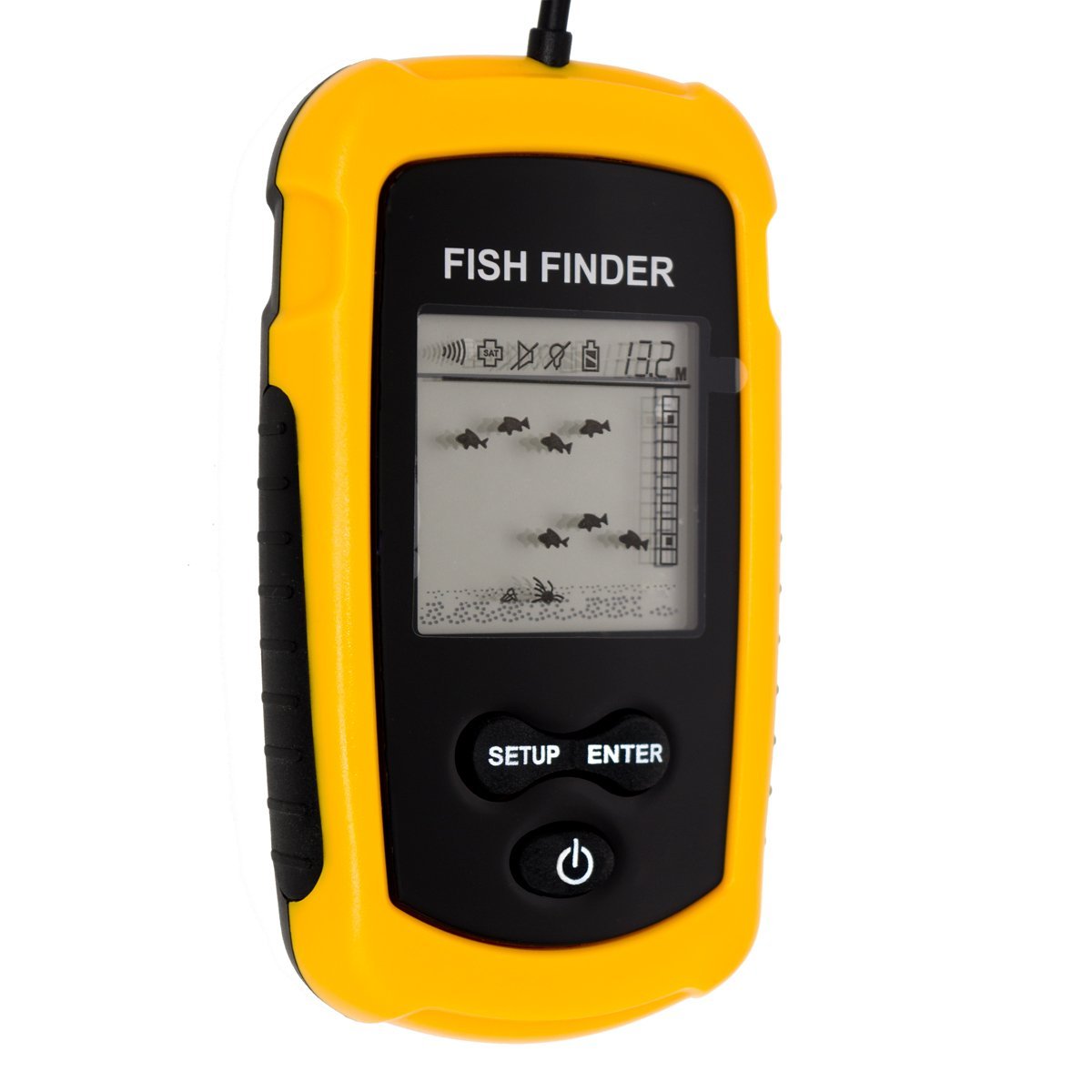
Pros
- thumbs-o-upCheap and simple.
- thumbs-o-upPortable – Easy to transfer between boats or kayaks.
- thumbs-o-upReasonably accurate depth readings.
- thumbs-o-upUp to 330ft (100m).
Cons
- thumbs-o-downSometimes confuses weeds with school of fish.
- thumbs-o-downNot very adjustable. Only one frequency.
- thumbs-o-downBlack and white display.
- thumbs-o-downNot overly durable – may be prone to leaks.
General Consensus
This is a very basic fish finder that gets the job done, no more, no less. Some of the nice features include its easy transfer between boats or kayaks, it’s easy to use, and perhaps most importantly – it’s really cheap; one of the cheapest on the market.
We mentioned it gets the job done, but we should make it clear that this fish finder is good for up to 330ft (100m). Anything deeper and it won’t be able to reach, so consider this fish finder best for shallow water. Other than the lack of advanced features (which you may or may not care about), we’ve heard a few complaints about durability and water leakage problems, but they seem few and far between.
Overall, we recommend this fish finder for those who primarily stick to shallow waters, don’t want to spend much money, and just need the basic features.
Mid-Range
Humminbird PiranhaMax Fish Finder
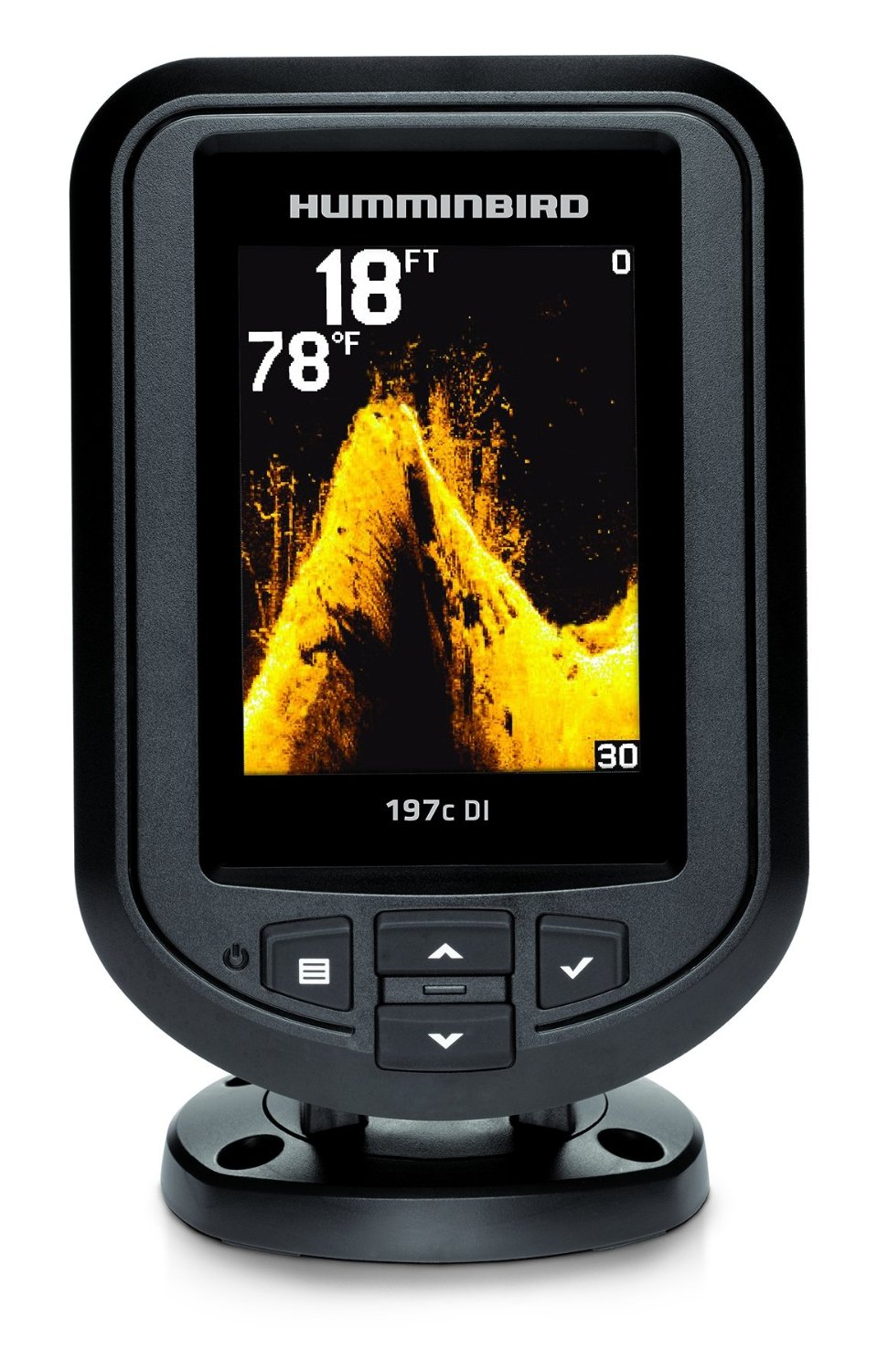
Pros
- thumbs-o-upDual Beam Transducer.
- thumbs-o-upDown Imaging.
- thumbs-o-upDepth up to 600ft with dual beam.
- thumbs-o-upSharp display with low glare.
Cons
- thumbs-o-downScreen might be too small for some (3.5″).
- thumbs-o-down12V battery required.
- thumbs-o-downNo boat speed.
General Consensus
This is a nice step up from the most basic type of fish finder. Humminbird is a popular and reputable fish finder brand that is known to deliver solid product.
This fish finder has some advanced features while still remaining relatively cheap and simple. The dual beam transducer allows the user to change the output frequency, which means you can adjust the settings to get the best image quality at a variety of depths.
The screen may be a little small for some, but otherwise it’s good because it tends to show up well in sunlight and has a relatively crisp picture. While you can measure the water temperature, it does not provide a reading of boat speed.
Overall, this is a great value fish finder that has some advanced features, but nothing too fancy. The simple design may be preferred by some, but if you have bad eyesight, we would recommend something with a larger screen. Those who fish in a variety of water depths, but don’t need anything too expensive or special, may benefit most from this fish finder.
High-End
Lowrance Elite-7 Gold CHIRP Fish Finder
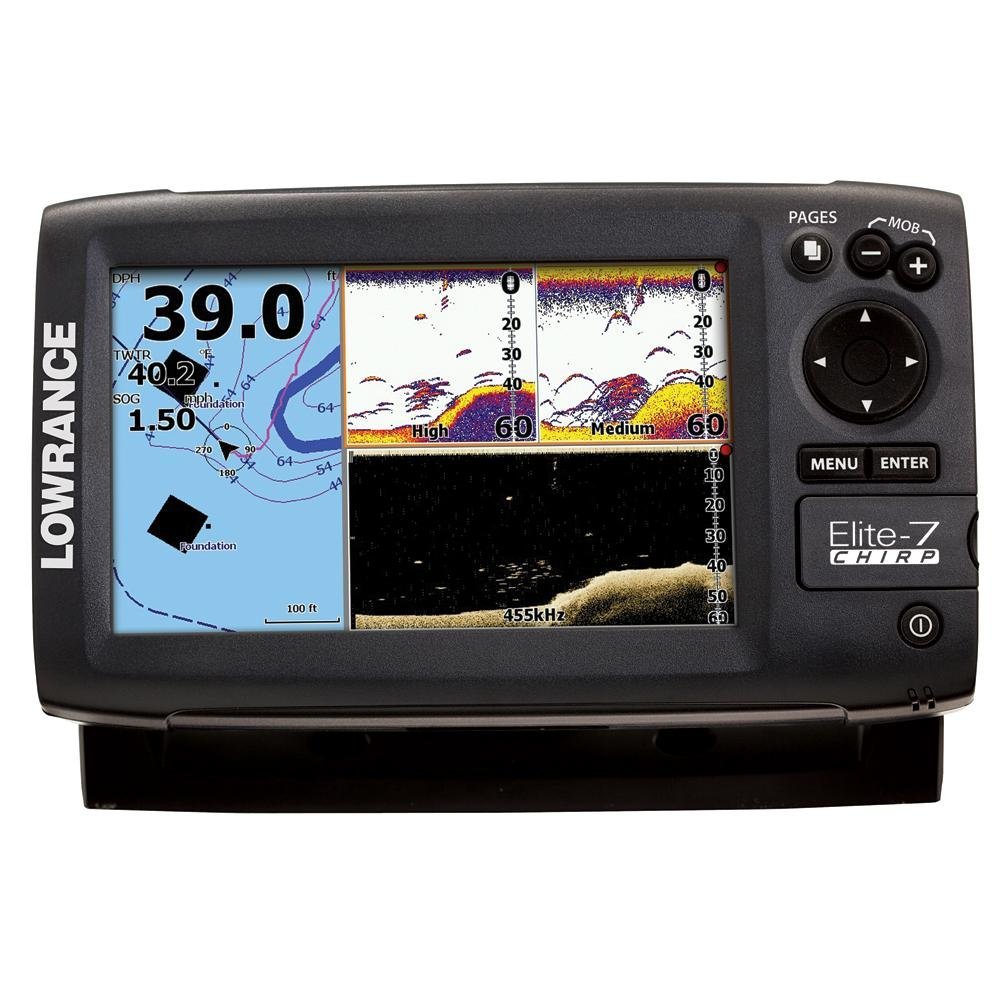
Pros
- thumbs-o-up7″ widescreen LCD.
- thumbs-o-upBroadband CHIRP.
- thumbs-o-upHD Down Imaging.
- thumbs-o-upBuilt-in GPS.
- thumbs-o-upNavionics Gold Cartography.
- thumbs-o-upMulti-window display.
Cons
- thumbs-o-downExpensive.
- thumbs-o-downGPS may be a little slow at times.
General Consensus
Lowrance is known to make good fish finders and they have lots of different models. The Elite-7 Gold is quite expensive, but it has all the bells and whistles a fisherman would want! The 7″ widescreen LCD display is great and the multi-window feature is definitely a bonus. Great for matching down imaging with the standard display.
The broadband CHIRP ensures that you will receive accurate and clear images in both shallow and deep waters. Very good at differentiating between clumps of weeds, fish, and other objects. The built-in GPS is a great feature to have as well.
Overall, this is an excellent fish finder, but it comes at a pretty steep price. While fishermen of all skill levels would definitely benefit from this, the steep price might not be worth it for some, so we recommend this for experienced fishermen or those who are not on a strict budget.
Pro
Humminbird 999ci HD SI Combo
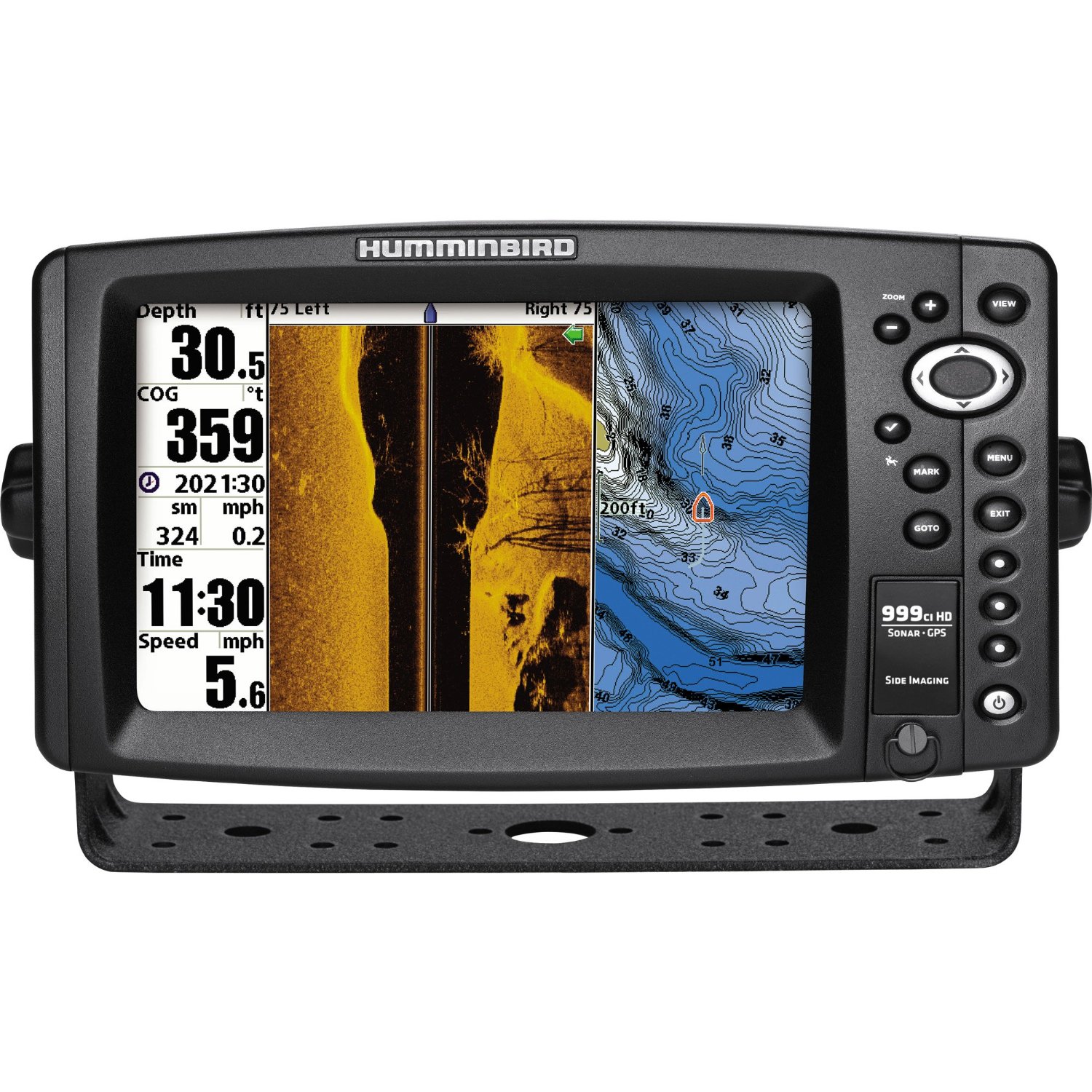
Pros
- thumbs-o-up8″ full color HD screen.
- thumbs-o-upMulti-window display.
- thumbs-o-upSide imaging provides 240ft on either side of boat.
- thumbs-o-upSwitch fire sonar can detect fish up to 1,500ft deep.
- thumbs-o-upInternal GPS.
- thumbs-o-upHigh-speed processor.
Cons
- thumbs-o-downVery expensive.
- thumbs-o-downTop-of-the-line model, but bang-for-your-buck not as great as some cheaper models.
General Consensus
This is a beautiful fish finder that boast pretty much any feature you would want. The side imaging is a really cool bonus and allows you to see a pretty good distance (240ft) on either side of the boat.
The console isn’t the only reason the display is so nice. The transducer is capable of emitting multiple frequencies within a very large range – from 50-800kHz. The internal GPS is great and performs well.
Overall, the Humminbird 999ci HD SI combo fish finder is one of the best fish finders you will be able to find. Tons of information, an excellent display, and powerful components make this fish finder hard to resist. The only drawback? The price. It’s well above the price point of the majority of fish finders.
We recommend this fish finder for fishermen who spend tons of time on the water and fish in many different locations and are willing to pay for the highest quality piece of equipment.
How Does a Fish Finder Work?
There are lots of different fish finders with a wide range of features and performance, but they all use a common technology: Sonar (Sound navigation and ranging). Fish finders use a certain type of Sonar referred to as “active sonar”. Basically, the fish finder will emit sound waves, and when those sound waves hit an object underwater they will be reflected back to the boat.
Given the speed of sound waves in different types of water is known, the fish finder will use that information, along with the time differences in the waves being reflected back, as well as subtle differences in absorption, to determine the location and size of fish in the water. Many fish finders are so well developed that you can see the water depth, fish of different sizes, and even subtle features like tall weeds and grass, which can be extremely helpful in avoiding snags!
For more information about what to look for in a fish finder, all the different features that can really make a difference, and other types of fish finders, please see our information below. Additionally, we tracked down a video of a really good interview (originally posted by Gary Palmer) with some helpful information about different types of fish finders and how to interpret what you see on the screen.
Best Smart Phone Fish Finders
With the recent push to have almost everything available for smart phones these days, fish finders have also joined the trend. Now, instead of being limited only to the standard fish finder packages, you can now also select from a variety of smart phone fish finders.
The function of the smart phone fish finders is actually pretty similar to a normal fish finder. The main difference lies in the console, whereby your phone can act as the console.
You still need a transducer, which is the part that does all the work finding the fish (see detailed explanations below to help with your selection), as well as an appropriate connection between the phone and transducer.
While many people find this to be a very convenient option, others prefer the standard fish finders, as you are less likely to damage your phone, and some people prefer to have their phone for emergencies rather than a tool for the boat.
In any case, it simply comes down to personal preference. Below we will outline some of the best value smart phone fish finders:
Basic
iBobber Castable Smart Fish Finder

Pros
- thumbs-o-upFairly inexpensive.
- thumbs-o-upEasily castable.
- thumbs-o-upDecent for bank fishing – very portable.
- thumbs-o-upIntuitive and nice display on select phones and tablets.
- thumbs-o-upAbility to tag and log hot spots in particular locations for future use.
Cons
- thumbs-o-downNot great for boats or reeling at fast speeds.
- thumbs-o-downReaches 135ft depth, so not ideal for deeper water.
- thumbs-o-downSome syncing issues at times.
General Consensus
This smart phone fish finder is on the more basic end, but if you’re trying to spend as little money as possible, it could be a nice option depending on where and what you fish.
The portability and wireless nature of this fish finder make it extremely handy, as well as practical for bank fishing especially if you move around a lot. It’s better for shallow waters, as the maximum depth range is 135ft.
If you plan on using this in a boat, you pretty much have to be using it when you are stationary. If you begin traveling at relatively fast speeds, it can start bouncing around and you don’t receive any useful information. But once you stop you can cast it out and it should work well up to 135ft.
Another nice feature of this smart fish finder is that you can tag and record hotspots on whatever body of water you’re on, so if you ever come back you can try the same spots or look for others. It’s nice to have this information on your phone and being able to look at it whenever you want.
Overall, this is a cheaper smart phone fish finder that gets the job done on shallow water and in a more stationary position. It’s a cool concept and really handy, but there have been quite a few complaints about annoying little issues like not syncing properly every time and less than desirable battery life. However, their customer service is known to be very good at addressing any of these issues, which is always a breath of fresh air.
We recommend this fish finder for those who simply want to check it out, bank fishermen who want an initial sense if there are no, or lots, of fish in certain area, and those who value portability and convenience on shallow water.
Mid-Range
FishHunter Military Grade Fish Finder 3.0
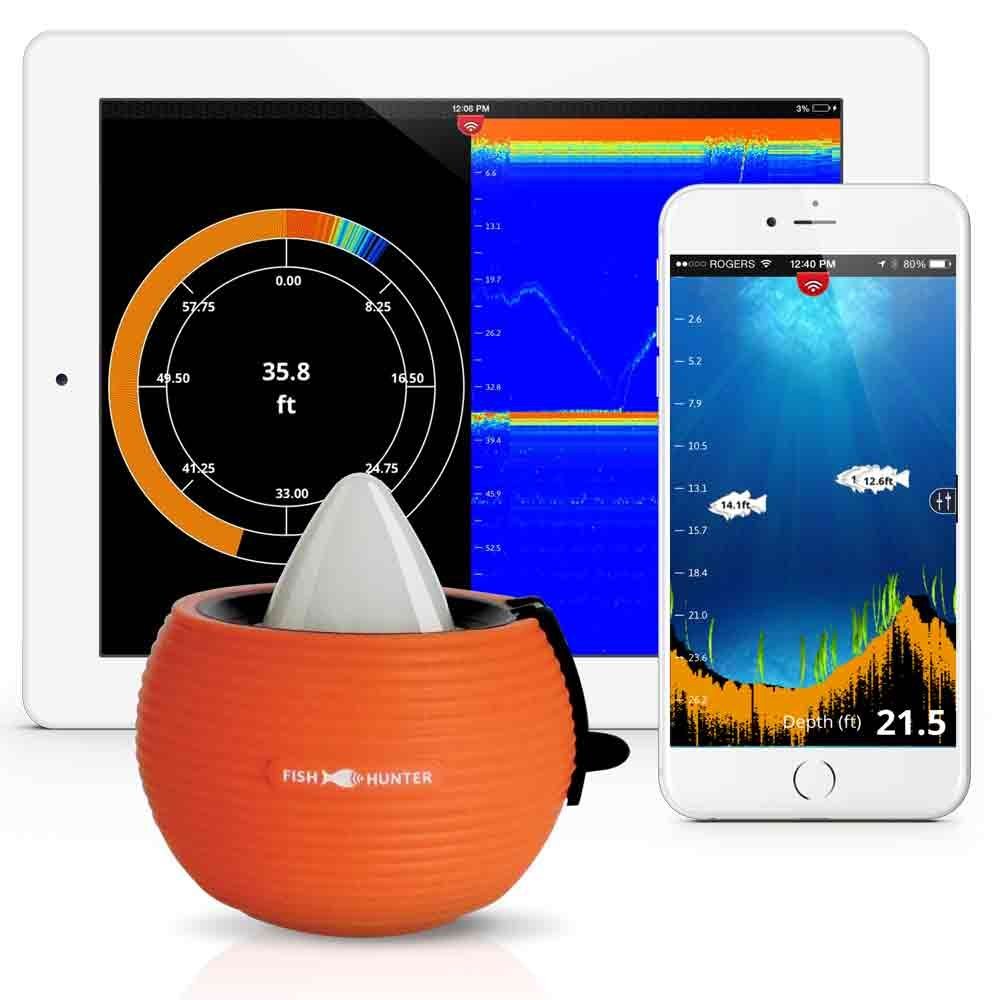
Pros
- thumbs-o-up380kHz transducer ideal for water depths up to 130ft.
- thumbs-o-upCan be used for ice fishing, bank fishing, from the kayak boat, and trolling.
- thumbs-o-upLeak-Proof.
- thumbs-o-upRubber casing for protection.
- thumbs-o-upDisplays fish, depth, bottom structures, and water temp.
Cons
- thumbs-o-downLower performance in currents or when traveling at any sort of speed.
- thumbs-o-downSome complaints about connection issues (often loses connection over extended periods of time).
General Consensus
This is a really cool portable fish finder that when it works, it works really well. It’s quite similar in function to the basic model that we reviewed, but it is a little more durable and all the features are a it more refined.
The FishHunter 3.0 is a little more versatile as well in that you can use it for ice fishing, on the kayak, and even trolling. It’s super convenient since it’s wireless and the console is simply your phone or tablet. The charge should hold for 8 hours, but we don’t know if that drops after long term repeated use. Like most electronics, our guess is that it will (we’ll have to wait and see!).
The main complaint about this fish finder is that it tends to lose the connection after it’s in the water for a while. Nothing is being damaged, it just seems to be a syncing issue. So even though you don’t require any reception for its operation, it can still be a little annoying to reset the connection a lot, especially if you have cast it pretty far out.
Overall, when this fish finder has a good connection established, it works great. With different views available, for example, the raw data mode and fish mode, you can receive a wealth of information. However, the connection issues have proved to be a bit too annoying for some.
Therefore, we would recommend the Fish Hunter 3.0 for those who have a bit of room in the budget to try a neat device, especially if you’re ice fishing, bank fishing, or fishing relatively stagnant and shallow water.
High-End
Deeper Wireless Fish Finder
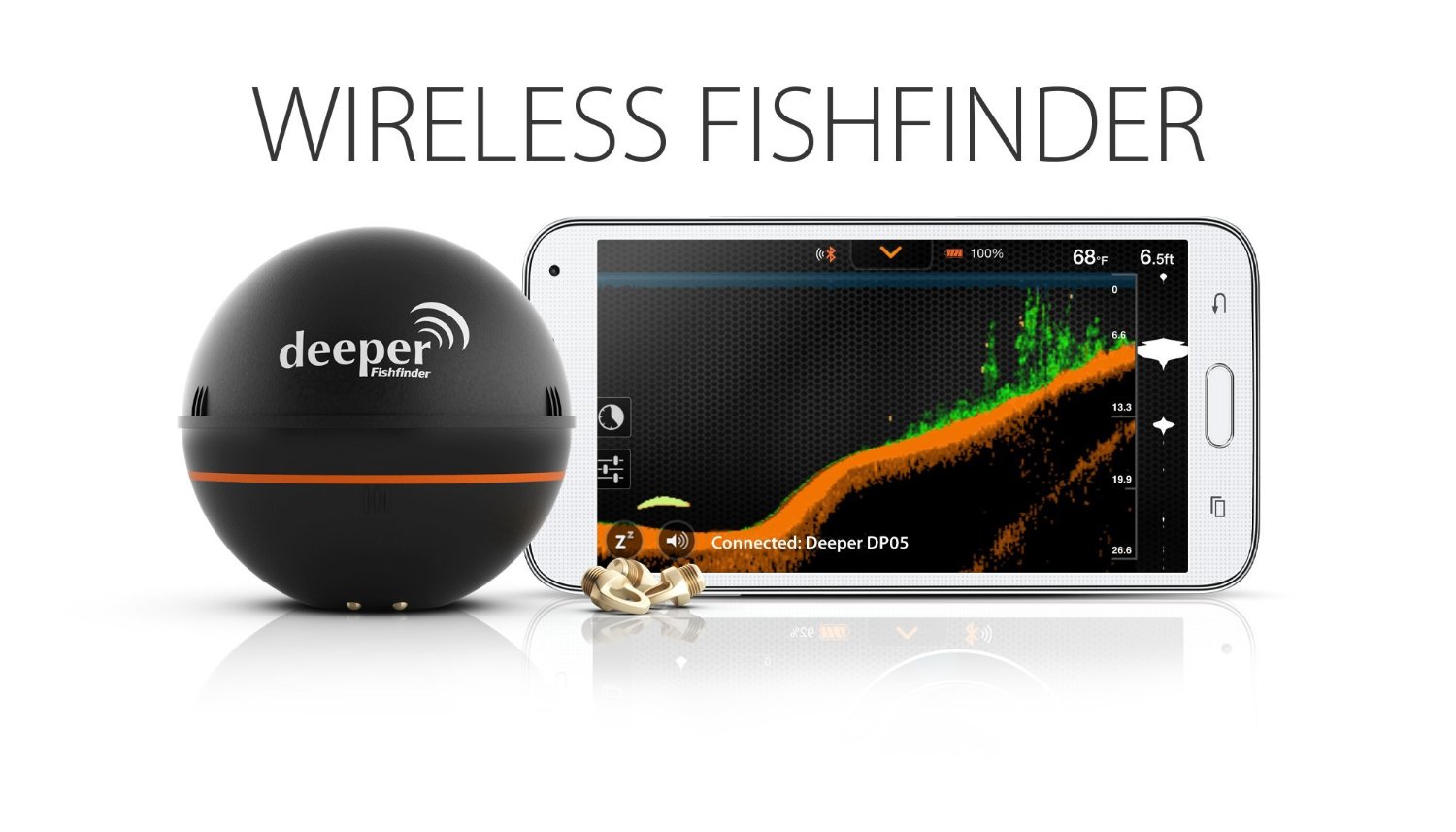
Pros
- thumbs-o-upDual beam Transducer – 290kHz (15 degree) and 90kHz (55kHz).
- thumbs-o-upFish appear in 4 different sizes.
- thumbs-o-upFast performance.
- thumbs-o-upSolid connectivity.
- thumbs-o-upCan read depths up to 130-150ft depending on water quality.
Cons
- thumbs-o-downExpensive – about twice the cost of the iBobber.
- thumbs-o-downLike most other smart phone fish finders, does not perform well at moderate-high speeds.
General Consensus
The Deeper DP0H10S10-P Wireless fish finder is a top-of-the-line smart phone fish finder. The main unique feature compared to other smart phone fish finders is the dual beam transducer, which really helps enhance image quality and may be able to scan a little bit further down.
Otherwise, there isn’t really anything new or unique about this fish finder, but all the features are enhanced from lower-grade models. Connectivity issues are rare, fish appear in 4 different sizes, and the software is much more flexible allowing you to customize the output to your needs.
The main drawback here is the price. It’s one of the more expensive smart phone fish finders that you can find, but if it has all the features you want and you’re not fishing in overly deep waters, this could still offer decent value since it’s about the same price as a mid-range standard fish finder.
Overall, this is a great smart phone fish finder that is useful for angling, boat fishing, kayak fishing, and even ice fishing. Customers tend to be quite happy with it, and while it’s expensive for a smart phone fish finder, it’s not too bad in the grand scheme of things.
Therefore, we would recommend the Deeper fish finder for those who have a little more wiggle room in their budget and want to ensure they get a high quality item.
How to Use a Smart Phone Fish Finder
Given that smart phone fish finders use your existing mobile device as the console, the set-up and function of the fish finder is a little different in this case. While all fish finder will behave somewhat differently particularly in terms of the interface, they will also have many similarities. Please check out the instructional video below to get a sense of how to operate a smart phone fish finder. The one being demonstrated is the Deeper fish finder reviewed above.
What to Look For in the Best Fish Finder
At Flannel Fishermen, one of our main priorities is to place an emphasis on value. We’ve all had a moment where we’ve spent more money on something than it was worth, and that’s what we would like to avoid.
That being said, we also recognize that often times you get what you pay for, so it can be difficult to determine what’s the best value for everyone, especially when everyone has the different preference.
In our reviews of the best fish finders, we provided our opinion on the best value fish finder. However, if you have a feeling that this may not apply to you, or you simply want to look around and make sure you’re getting something you want and need, we feel it is important to describe all of the common fish finder features so that you can make your own informed decision.
Features of The Best Fish Finder
Fish Finder Transducer
When you’re looking around for fish finders online, the display image is often on the console/screen that you look at while in the boat. However, this piece doesn’t really do the “heavy lifting”, rather, another piece called the transducer is where the bulk of the work takes place.
The formal definition for “transduce” is the process of converting one type of energy to another. In the case of a fish finder, the transducer emits sound waves (or “pings”), then receives the returning signal and sends that to the console in the form of an image.
Therefore, the transducer is often mounted on a different part of the boat than the console, usually connected by a cable.
Most fish finders will already come with a transducer, so you don’t have to worry about trying to match a fish finder with the correct transducer. However, we do recommend paying close attention to the transducer specs because different water conditions will require different transducer settings for optimal detection of fish and smaller objects. Similarly, perhaps you already have a fish finder and want to change to transducer because you now own a different boat or fish different waters than you used to. In any case, knowing the basics of transducers can really help you feel comfortable in the choice you make.
Transducer Frequency
We won’t get overly technical here, but the frequency is one of the more important specs to pay attention to when picking out a fish finder and associated transducer. First of all, how do you know what number is the frequency if it is not labeled with “frequency”?
Frequency is measured in the units “Hz” (Hertz), where 1 HZ means 1 per second. Fish finders typically operate in kHz, so if you see this unit, then you’re looking at the frequency! Some of the most common frequencies you will see are 50kHz, 83kHz, and 200kHz.
If you have been looking for a fish finder already, you may have noticed that often times there is a “/” (slash) between two numbers, such as 50/200. This means that the transducer can operate both at low-frequency and high frequency.
The fish finder will either be able to toggle back and forth between the frequencies, or sometimes they can display both in a split-screen appearance.
What Frequency Do You Need For Your Fish Finder Transducer?
Low-frequency (e.g. 50kHz) and high frequency (e.g. 200kHz) transducers each have their own strengths and limitations that are pretty much opposite of each other. Depending on where you’re fishing, a low frequency may be more suitable than a high frequency, or vice versa. Here’s the basic information you should know when selecting a transducer frequency:
Low frequency pulses can travel further through water. Therefore, if you are fishing in deep water and want to know the water depth, as well as see any bottom dwellers or snag-prone objects, then a lower frequency may be best in that situation.
If the water isn’t too deep, then you may prefer a higher frequency, as the pulses simply won’t need to travel as far. Furthermore, high frequency pulses offer better detail on the screen, and therefore may be better at picking up smaller fish or details about the vegetation in the water.
If you’re on a lake with varying depth, type of fish, or water clarity, then it may be beneficial to have a Fish finder with both low and high frequencies available.
It’s tough to know exactly what frequency will be needed for a particular depth because it also depends on water temperature and murkiness (lower frequencies are better for murkier water). The “general” threshold commonly used is 200 feet, whereby higher frequencies, especially a single frequency, may be best suited to water depths under 200 feet.
Lower frequencies, such as 50kHz, are likely to be better for water depths greater than 200 feet. But like we said, this is a general guideline and not meant as a written-in-stone rule.
Transducer Power
If you’re on the hunt for a new fish finder, the power, which is basically the strength of the signal being emitted, won’t be an overly important spec to consider assuming you are already considering the frequency.
In a nutshell, lower frequencies are typically coupled with a higher power, and higher frequencies are usually coupled with a lower power. Given what we already know about transducer frequency, we can guess that lower power is ideal for reaching greater depths.
This is in fact the case, and is why you will often see frequency reported in the product description, but power may be a little more difficult to find. If you are looking for the power of a particular transducer, it will have Watts (W) as the units, and they usually range in the area of 100-1000W (RMS).
One thing to note about transducer power is that while you may be able to mix and match components of different fish finders, mixing components from systems with way different power specs can decrease the longevity of your fish finder.
So while it could work in a pinch, and sometimes even improve the quality of the images you receive if you swap to a transducer with a higher power, that may come at the cost of decreased durability.
Transducer Beam Width or Angle
If you’re learning about the different features of fish finders, often times you will see information about the beam width or beam angle of the transducer. This can be considered your area of coverage, or the area you are able to “see” underwater.
When the sound pulses are emitted from the transducer, they are emitted in the shape of a cone, whereby the covered area grows larger the deeper the sound penetrates (like an upside-down ice cream cone). Therefore, smaller beam angles cover less area while larger beam angles span a larger area.
The beam width of your fish finder will depend largely on the frequency. The lower the frequency, the larger the beam angle. The higher the frequency, the smaller the beam angle.
Low frequency/large beam angles are great for covering a large area underwater and gaining a general sense of where the fish are and how many there are. High frequency/narrow beam angles are great for shallow depths and provide more detail of the underwater environment.
What Does CHIRP Mean?
You may have noticed that lots of fish finders now incorporate a function called CHIRP, especially in recent years. CHIRP stands for Compressed High-Intensity Radar Pulse. The technology has actually existed for a long time and has been primarily used in industrial and military settings, but like lots of other technology, it has become cheaper and more well-understood in recent years, making it more practical to use for recreational purposes.
Now, CHIRP is very popular when it comes to fish finders.
So what are the advantages of CHIRP? It’s basically a more advanced way to get the most out of a transducer. What CHIRP does is sends a sound pulse that is a bit longer than normal pulses from standard transducers.
The pulse is emitted at a low frequency, but ramps up to a much higher frequency. Since the pulse time is longer, the fish finder can scan over an entire range of frequencies instead of just a few discrete frequencies.
Why does this matter if you can already see the fish and underwater environment with a single- or dual-frequency transducer? While CHIRP may not be totally necessary to spot fish, it certainly helps in creating a much more detailed image.
The range of frequencies tied together with the longer pulse duration leads to a higher resolution and may also be able to provide more detailed images at greater depths.
Fish Finder Transducer Summary
- lightbulb-oShallow water = high frequency = narrow beam angle = less area covered, but greater detail.
- lightbulb-oDeep water = low frequency = wider beam angle = more area covered, but less detail.
- lightbulb-oCHIRP = wide range of frequencies = more detail.
Fish Finder Console
Alright, enough about how best fish finders work, just show me the fish! The console is the part of the fish finder that will map out the depth and display any fish in the area. There is actually quite a variety of consoles available, from black-and-white to color, from a small to the large screen, different resolutions, etc.
So while it’s extremely important to focus on the transducer specs, knowing more about the console can increase the chance that you will end up with a fish finder that is perfect for your needs and wants.
Console Screen Size
This is a pretty simple one. Many people like consoles with a larger screen, but they tend to be more expensive as well. Chances are if you’re looking at a fish finder that is relatively expensive and has a large screen, that it may also be capable of displaying more than one image.
For example, dual frequency fish finders can sometimes display a split-screen image, but you need a large enough screen for this. So if you’re wondering why it’s so much more expensive for a fish finder with a larger screen, check the more specific capabilities like dual frequency and split-screen display, as that may be a factor as well.
However, please keep in mind that a large screen doesn’t have to mean advanced capabilities, there’s just a decent chance that it does.
One thing to keep in mind about screen size, especially if you are looking for a fish finder as a gift, is eyesight. While fish finders are often mounted in convenient locations on the boat, you won’t always necessarily be directly next to it.
It can be a hassle to always have to get to the screen, move in close, and squint to see what’s on it, so if any eyesight issues are at play, it’s probably better to lean towards a console with a larger screen.
Console Screen Resolution
May you notice some brands boasting or higher-end fish finders boasting about their higher screen resolution?
So why does the resolution on the screen of a fish finder matter?
Simply put, the more pixels there are on the screen, the more detail can be displayed.
But how do you know how many pixels are on the screen?
If you look at a product description and see something like ‘480×640’, that means the screen is 480 pixels wide by 640 pixels tall. Sometimes you may also see or hear “high definition” or “HD”. While there are subtle differences between “resolution” and “definition”, they are practically the same when it comes to the actual application.
Without going too in-depth, there is a little bit of interplay with screen size. Larger screens are usually capable of packing in more pixels, so it’s a good idea to consider both.
For example, let’s say we have the one really small screen and one really large screen, both with the same resolution.
There will be no difference in the amount of information displayed. The big screen will simply display a larger image. However, let’s say we have two screens that are the same size, but one is high resolution and the other is low resolution. The high-resolution screen will provide more detail than the low-resolution screen.
So are there any disadvantages to using a screen with higher resolution?
Sort of. A higher resolution will often mean that more information is displayed on the screen, which can make any text or other parts of the image a bit smaller.
That being said, the companies that make fish finders are well aware of this, so they won’t build and sell a product that people can’t see. Moreover, best fish finders usually have images on the box of what the screen looks like when it’s in use, or at the very least, you can find some images online. In any case, I personally wouldn’t be too worried about a fish finder screen having “too high” of a resolution.
Down Imaging
On certain fish finders, usually the higher-end models, you may notice they talk about “down imaging”, “DI”, “down view”, or “DV”, or some variation of that general form. This is a pretty cool feature that can definitely come in handy at any time, but especially if you are in an area with lots of vegetation on the sea/lake floor, or if you’re trolling close to the shore.
The benefit of down imaging is that it can provide a much clearer view of what is directly under your boat. In this case, a high-frequency sound waves are sent out in really small “slices” instead of a wide cone.
The result is a very clear image that almost looks like a photograph because it provides so much detail, it just cannot cover as large of an area as the standard transducer function. However, these down view images can usually share a screen with the standard display in order to provide a comprehensive sense of the underwater environment around you.
Black and White vs Color Console Screen
The obvious tendency here would be to go for a color screen, but color screens are often more expensive, so is it really worth it go with an expensive color screen over a cheaper black and white display? Here are a few things to consider when trying to make this decision:
Color screens tend to offer better contrast and are often better for identifying fish that are close to other objects, such as the bottom and associated vegetation. Color screens can also sometimes employ higher resolution, which could further assist in this matter.
So when is a black and white display favorable? For starters, if you are on a budget, then you can definitely find cheaper black and white displays. Similarly, if you are a beginner and not really sure what your preferences are or how much you will use it, then we would suggest a basic model learn on first, and this will likely be black and white.
At the end of the day, it’s not only about black and white versus color. All features need to be considered, and perhaps one particularly important feature to consider along with display color is screen resolution.
In our opinion, resolution, or “pixel count”, is much more important than the color of the screen. So let’s say you are deciding between a black and white display and a color display.
If you notice the black and white display has a higher screen resolution than the color display, then the black and white display could be a good option if you are looking to save some money with the best fish finder and don’t need anything overly advanced.
